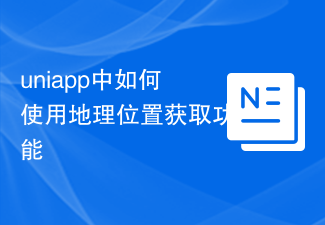
How to integrate third-party login function in uniapp
In today's social media era, third-party login function has become indispensable in many applications part. By integrating third-party login functions, users can use accounts on other platforms to quickly log in and use applications. This article will take uniapp as an example to introduce how to integrate the third-party login function in uniapp and provide specific code examples.
- Create a third-party open platform application
First, you need to register and create an application on the corresponding third-party open platform. Common third-party login platforms include WeChat, QQ, Weibo, etc. When you register your app, you will get the relevant app ID and key, which will be used in subsequent integrations. - Install uniapp third-party login plug-in
Uniapp provides some commonly used third-party login plug-ins, through which we can quickly integrate third-party login functions. In the uniapp plug-in market, you can search for the corresponding login plug-in and install it. - Import plug-in
In your uniapp project, find the manifest.json file of the project and add the plug-in configuration information there. The specific configuration method is as follows:
"permission": {
"webview": {
"domain": "yourdomain, yourdomain" // 添加第三方登录域名
},
"oauth": {
"scopes": [
"auth_user" // 添加所需要的登录权限
],
"clientId": "yourAppId", // 替换为您的应用ID
"authorize": "https://api.example.com/oauth/authorize", // 替换为授权地址
"token": "https://api.example.com/oauth/access_token" // 替换为获取token地址
}
}- Write the login button and related event processing logic
In the uniapp page, add a button and write the relevant login in the click event of the button logic. In this login logic, you need to call the login interface provided by uniapp and pass in the corresponding parameters to complete the third-party login process.
<template>
<button @tap="login">第三方登录</button>
</template>
<script>
export default {
methods: {
login() {
uni.login({
provider: 'oauth', // 替换为您使用的第三方平台名称
success: (res) => {
console.log('登录成功', res)
},
fail: (err) => {
console.log('登录失败', err)
}
})
}
}
}
</script>In the above code, we call the third-party login interface through the uni.login method and pass in the corresponding parameters. After successful login, login-related information can be obtained in the success callback function, such as the user's unique ID, avatar, nickname, etc.
- Verify login credentials and obtain user information
After successful login, you may also need to call the interface of the third-party platform through the login credentials to obtain the user's detailed information. This process will vary according to different third-party platforms, and you need to refer to the corresponding documentation to obtain it.
uni.checkSession({
success: () => {
// session_key 未过期,并且在本生命周期一直有效
uni.getUserInfo({
provider: 'oauth',
success: (res) => {
console.log('获取用户信息成功', res.userInfo)
},
fail: (err) => {
console.log('获取用户信息失败', err)
}
})
},
fail: () => {
// session_key 已经失效,需要重新执行登录流程
console.log('登录凭证过期,重新登录')
}
})In the above code, we verify the validity of the login credentials through the uni.checkSession method. If the login credentials are valid, we can get the user's details through the uni.getUserInfo method.
Through the above steps, we have successfully integrated the third-party login function into uniapp. When the user clicks the login button, they can choose a third-party platform to log in and obtain the corresponding user information. In this way, you can easily use your existing third-party platform account to log in and use the application.
It should be noted that when integrating the third-party login function, you need to make the corresponding configuration and parameter settings according to the specific third-party platform documents. Each third-party platform may have different authorization addresses, token acquisition addresses, etc., and you need to replace them accordingly.
I hope this article will help you integrate the third-party login function in uniapp. I wish your application a better user experience and user growth!
The above is the detailed content of How to integrate third-party login function in uniapp. For more information, please follow other related articles on the PHP Chinese website!
 如何在uniapp中实现相机拍照功能Jul 04, 2023 am 09:40 AM
如何在uniapp中实现相机拍照功能Jul 04, 2023 am 09:40 AM如何在uniapp中实现相机拍照功能现在的手机功能越来越强大,几乎每个手机都配备了高像素的相机。在UniApp中实现相机拍照功能,可以为你的应用程序增添更多的交互性和丰富性。本文将针对UniApp,介绍如何使用uni-app插件来实现相机拍照功能,并提供代码示例供参考。一、安装uni-app插件首先,我们需要安装一个uni-app的插件,该插件可以方便地在u
 怎样使用Facebook SDK进行第三方登录操作?Jun 12, 2023 pm 07:08 PM
怎样使用Facebook SDK进行第三方登录操作?Jun 12, 2023 pm 07:08 PM在互联网的时代中,社交媒体应用变得越来越普及,而Facebook是其中最受欢迎的一个。通过使用Facebook,您可以创建一个账户并与家人、朋友或客户保持联系,也可以使用Facebook登录访问其他第三方应用或网站。这种登录方式对于用户来说非常方便,而对于开发人员来说也可以简化账户管理和开发过程。在本文中,我们将介绍如何使用FacebookSDK进行第三方
 如何使用Hyperf框架进行第三方登录Oct 25, 2023 am 09:16 AM
如何使用Hyperf框架进行第三方登录Oct 25, 2023 am 09:16 AM如何使用Hyperf框架进行第三方登录引言:随着互联网的发展,第三方登录已经成为了许多网站和应用程序的标配功能。通过第三方登录,用户可以使用自己在第三方平台上已有的账号信息登录到其他网站或应用程序中,避免了繁琐的注册流程,极大地提高了用户体验。本文将介绍如何使用Hyperf框架实现第三方登录功能,并附带具体的代码示例。一、准备工作在开始实现第三方登录之前,我
 Laravel开发:如何使用Laravel Socialite实现第三方登录?Jun 14, 2023 pm 03:04 PM
Laravel开发:如何使用Laravel Socialite实现第三方登录?Jun 14, 2023 pm 03:04 PMLaravel开发:如何使用LaravelSocialite实现第三方登录?在现代化的Web应用程序开发中,第三方登录已成为一项非常重要的功能。与传统的用户名和密码登录相比,第三方登录可以提供更方便、更快捷的登录体验,并且可以帮助网站或应用程序增加新用户。在Laravel框架中,使用LaravelSocialite扩展包可以非常方便地实现第三方登录。本文
 PHP实现第三方登录功能Jun 22, 2023 pm 10:50 PM
PHP实现第三方登录功能Jun 22, 2023 pm 10:50 PM随着互联网的发展,越来越多的网站都开始支持第三方登录功能。通过第三方登录,用户可以使用自己已有的社交账号(如微信、QQ、微博等)作为登录凭证,避免了反复注册、记住各种账号密码的困扰,极大地提高了用户体验。本文讲述如何用PHP实现第三方登录功能,以微信登录为例。第一步:获取微信开放平台账号要实现微信登录,首先需要拥有一个微信开放平台的账号。在微信开放平台注册账
 ThinkPHP6第三方登录集成:实现一键登录功能Aug 12, 2023 pm 06:19 PM
ThinkPHP6第三方登录集成:实现一键登录功能Aug 12, 2023 pm 06:19 PMThinkPHP6第三方登录集成:实现一键登录功能在现代的互联网应用中,用户可以通过第三方平台登录应用,这大大方便了用户的注册和登录过程。ThinkPHP是一个知名的PHP框架,对第三方登录的集成也相对简单。本文将介绍如何使用ThinkPHP6框架实现一键登录功能。创建第三方应用首先,我们需要在目标第三方平台上注册一个应用,以获取应用的AppID和AppSe
 手把手教你uniapp和小程序分包(图文)Jul 22, 2022 pm 04:55 PM
手把手教你uniapp和小程序分包(图文)Jul 22, 2022 pm 04:55 PM本篇文章给大家带来了关于uniapp跨域的相关知识,其中介绍了uniapp和小程序分包的相关问题,每个使用分包小程序必定含有一个主包。所谓的主包,即放置默认启动页面/TabBar 页面,以及一些所有分包都需用到公共资源/JS 脚本;而分包则是根据开发者的配置进行划分,希望对大家有帮助。
 uniapp中如何使用地理位置获取功能Jul 04, 2023 am 08:58 AM
uniapp中如何使用地理位置获取功能Jul 04, 2023 am 08:58 AMuniapp是一种基于Vue.js的跨平台开发框架,它可以同时开发微信小程序、App和H5页面。在uniapp中,我们可以通过使用uni-api来访问设备的各种功能,包括地理位置获取功能。本文将介绍在uniapp中如何使用地理位置获取功能,并附上代码示例。首先,在uniapp中使用地理位置获取功能,我们需要在manifest.json文件中申请权限。在man


Hot AI Tools

Undresser.AI Undress
AI-powered app for creating realistic nude photos

AI Clothes Remover
Online AI tool for removing clothes from photos.

Undress AI Tool
Undress images for free

Clothoff.io
AI clothes remover

AI Hentai Generator
Generate AI Hentai for free.

Hot Article

Hot Tools

mPDF
mPDF is a PHP library that can generate PDF files from UTF-8 encoded HTML. The original author, Ian Back, wrote mPDF to output PDF files "on the fly" from his website and handle different languages. It is slower than original scripts like HTML2FPDF and produces larger files when using Unicode fonts, but supports CSS styles etc. and has a lot of enhancements. Supports almost all languages, including RTL (Arabic and Hebrew) and CJK (Chinese, Japanese and Korean). Supports nested block-level elements (such as P, DIV),

Notepad++7.3.1
Easy-to-use and free code editor

MinGW - Minimalist GNU for Windows
This project is in the process of being migrated to osdn.net/projects/mingw, you can continue to follow us there. MinGW: A native Windows port of the GNU Compiler Collection (GCC), freely distributable import libraries and header files for building native Windows applications; includes extensions to the MSVC runtime to support C99 functionality. All MinGW software can run on 64-bit Windows platforms.

Atom editor mac version download
The most popular open source editor

SublimeText3 Linux new version
SublimeText3 Linux latest version






